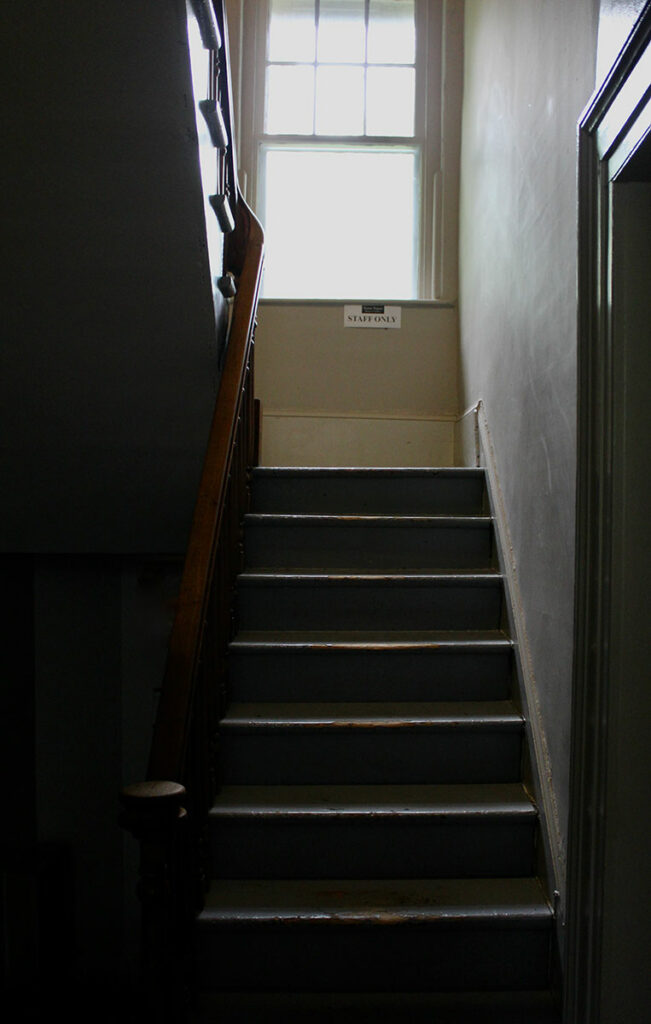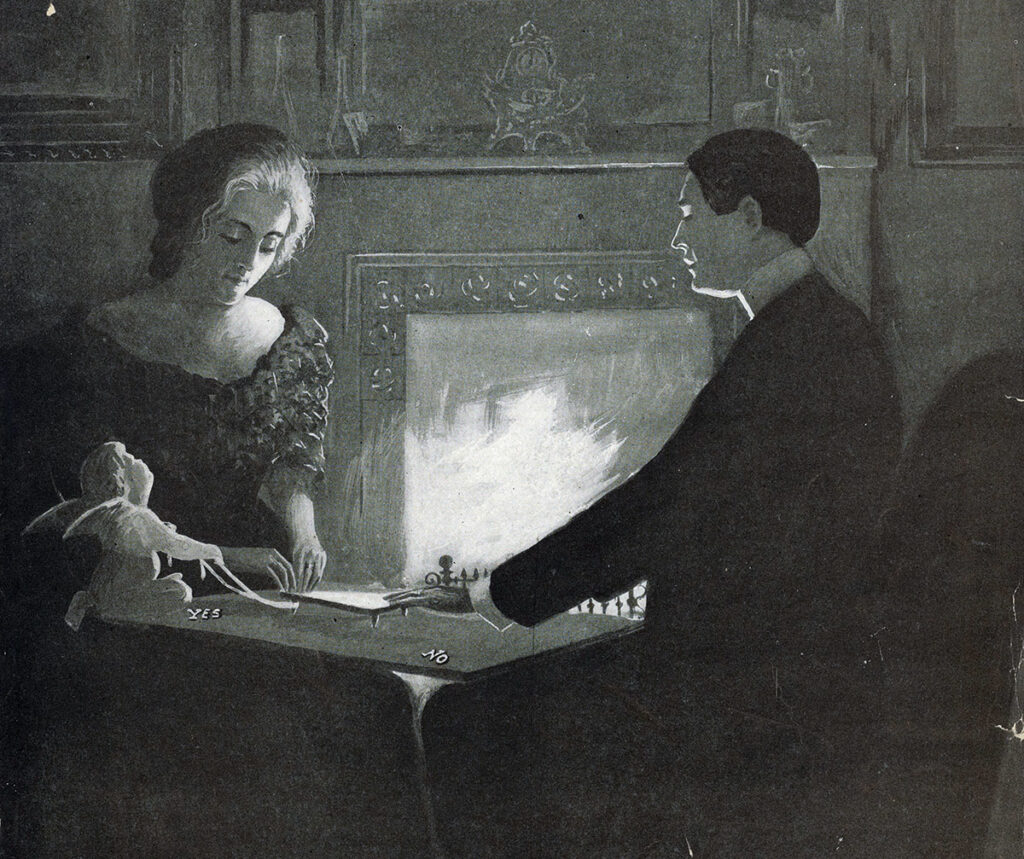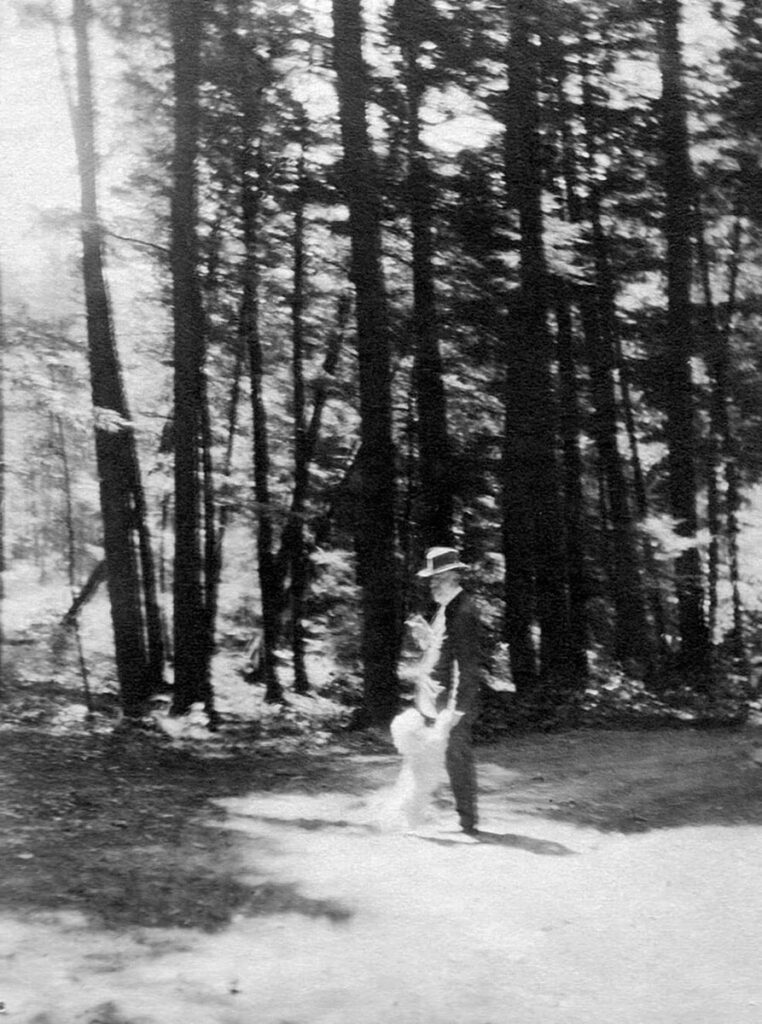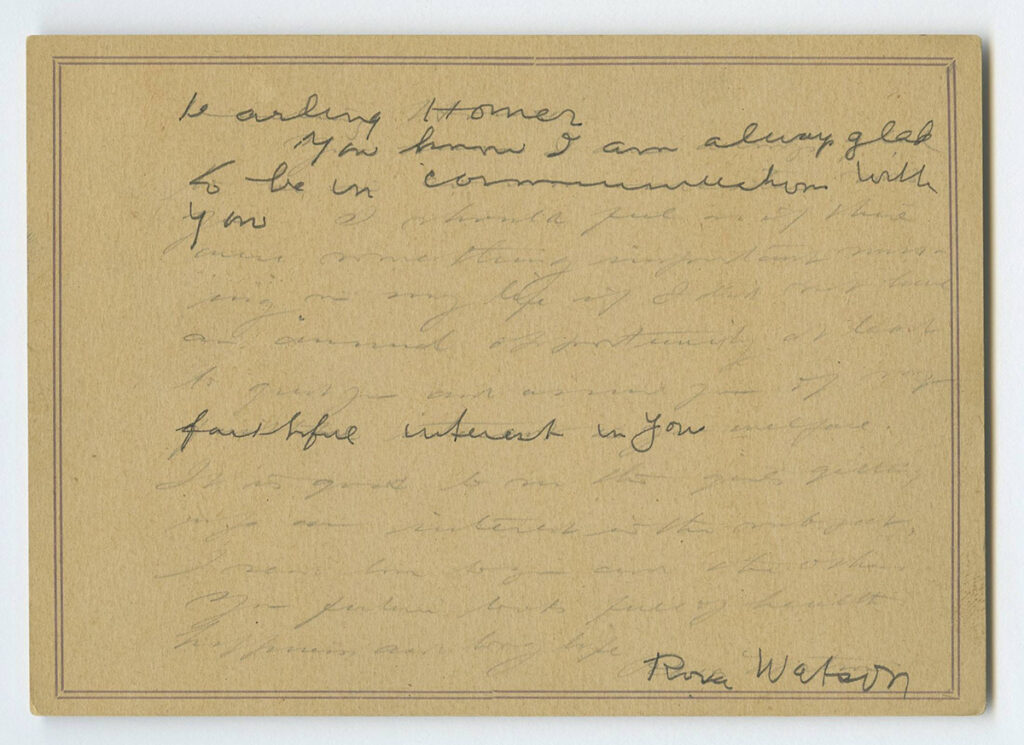Homer Watson: Spiritualism
Spiritualism is a faith based on the belief that spirits of the deceased can communication with the living, particularly through using a medium. Though Homer Watson had likely been introduced to concept earlier in his lifetime, it was the death of his wife Roxa in 1918 that pushed him to view the Bible through a new spiritualist lens. A vision he had of his wife’s ghost and the books written by British author and psychic researcher Sir Arthur Conan Doyle are two sources of inspiration towards his belief in spirits.
He began telling his friend that, as he sat in his studio in an hour of pensive musing on the barrenness of his life a short while before, the vision of his wife had appeared in a curious amber glow, life-like and seemingly tangible. So natural had she looked, that he had risen to meet her. But she had faded away, and he had slumped into his chair. Again the vision returned, but, this time, he made no move and the apparition slowly smiled and her lips parted. Then she said: “Do not despair. All is well, Homer.” Beside himself, he cried out, “Roxa, come back!” But, this time, the vision faded not to return.[1]
Dear Sir Arthur
I cannot begin to tell you with what pleasure and profit I heard you last night. If you are not too busy I would like a few words with you. I have been much alone with this great truth having firsthad the [last] of materialism knocked from under me by reading your book The New Revelation just after I lost my wife.[2]
The materialism Homer references in his letter to Conan Doyle is the belief that everything in the world is the result of physical processes, whereas spiritualism argues for the existence of the immaterial spirit or “soul” that remains present in the world after a person’s body has died. Conan Doyle’s book The New Revelation poses that “if spirit can live without matter,” i.e., a body, “then the foundation of materialism is gone.”[3] However, despite his participation in spiritualist practice, Homer noted in a letter to his brother-in-law that he didn’t “believe in it as a religion”[4], but rather saw it as adhering to “nature’s law”[5].
Homer’s primary involvement with spiritualism was through séances. They were held at his Doon home as well as other places around Ontario, such as Paradise Lake. Specifically, they were held at David Forsyth’s Paradise Lake cottage. Besides being a well-known educator, soccer player, and a member of the Grand River Canoeing Club, Forsyth was also at one time the President of the Ontario Society for Psychic Research.[6]
At one such Paradise Lake séance, Homer describes receiving messages through maple trees which told him by raps on the head (knocking sounds) a message from the then deceased “old man Perine”:
It was at a seance in Paradise Lake that Maple trees came and rapped me on the head and by raps told me when asked is there anyone from my diggings here from Doon raps, yes, who, Old Man Perine what is he doing there, picking up string – a peculiarity he had of picking up bits and making it into a ball saving it, although a manufacturer of it in quantity.[7]
Lily Dale
Lily Dale is a small hamlet located in the Town of Pomfret, in New York state. Originally known as the Cassadaga Free Lake Association, it was incorporated as a community in 1879 and renamed Lily Dale in 1906. The community had a “summer camp”[8] atmosphere, and filled with cottages, amphitheatres, and picnic pavilions as likeminded Spiritualists gathered from all over.[9] Lily Dale is still around today as the largest Spiritualist community in North America, with year-round meetings, seminars, and workshops surrounding the topics of mediumship, spiritual healing, and other kinds of psychic phenomena.
In one letter, Homer refers to visiting a specific Lily Dale medium – Pierre Louis Ormand Augustus Keeler:
Dear Sir
I would like a place at your light séance Aug 5th I understand that is the date. Saturday night – also for three of my friends. We all wish to try for slate messages the following Monday. It seems in my mind this is the procedure. I am an old visitor with Mr. D. Forsyth of Kitchener, Ont who I am sorry to say cannot go this year. The friends I bring are sympathetic and with me would like places right in front for myself as I am somewhat deaf and for my friends who are novices and I wish them to get the wonders of the séance at the best possible vantage. [10]
The “slate writing” noted by Homer is a type of mediumship in which messages from spirits allegedly manifest on a slate without physical intervention. Unfortunately for Homer, Keeler was caught as a fraud multiple times – including by magician and skeptic Harry Houdini.[11]
Besides slate-writing and séances, Myrtle Bean[12] alleges that Homer also received messages from spirits at Lily Dale from mediums using automatic writing. Automatic writing is the claim that mediums can allow spirits to move their hands and write down notes, letters, and other communications. Several of these “spirit cards” are held in Homer Watson House & Gallery’s collection, many of which include reassurances of continued love from Roxa’s supposed spirit.
Camp Chesterfield
The other spiritualist camp visited by Homer Watson was Camp Chesterfield in Indiana, which he also attended alongside David Forsyth. Founded in 1891, Camp Chesterfield followed a similar set up as Lily Dale – with tents, cabins, and other outdoor meeting places. During this visit, Homer commented on the hospitality of the mediums, writing “so kind and nice they are”[13], and that Forsyth’s son, Otto, was hoping to meet up with a medium referred to as “Dr. Burroughs”.
Homer’s letters also make specific reference to spirit photography at Camp Chesterfield. Spirit photography is the phenomenon of ghostly figures appearing in the background of a picture, oftentimes using double exposure or reflective surfaces to create the effect. However, believers may say that some occurrences are supernatural in nature.
Just had my photo taken. I hope Roxa mother father and Jude will be on the plate but I don’t expect such luck. I suppose there will be a lot of [mediums]. They always get in.[14]
There’s a possibility that the “spirit portrait” in Homer Watson House & Gallery’s collection may have been taken on this trip to Indiana.
[1] Muriel Miller, Homer Watson the Man of Doon 2nd ed. (Toronto: Summerhill Press, 1988), 94
[2] Letter from Homer Watson to Sir Arthur Conan Doyle, n.d., Homer Ransford Watson fonds F523-f5, Queens University Archives, Kingston
[3] Arthur Conan Doyle, The New Revelation 5th ed., (London: Hodder and Stoughton, 1918), 68
[4] Letter from Homer Watson to Alexander Biggs, March 28, Homer Ransford Watson fonds F532-f5, Queens University Archives, Kingston
[5] Ibid.
[6] Gerald Noonan, Refining the Real Canada: Homer Watson’s Spiritual Landscape: A Biography, (Waterloo: mlr Editions), 225
[7] Note written by Homer Watson regarding spiritualism, n.d., Homer Watson House & Gallery Archive, Kitchener
[8] Christine Wicker, Lily Dale: The Town That Talks to the Dead, (New York: HarperCollins, 2003), 2
[9] Bil Gilbert, “In Good Spirits”, Smithsonian Magazine, May 31, 2001
[10] Letter from Homer Watson to P.L.O.A. Keeler, July 24, Homer Ransford Watson fonds, F523-f4, Queens University Archives, Kingston
[11] Kembrew McLeod, Pranksters: Making Mischief in the Modern World, (New York: New York University Press, 2014), 88
[12] The original envelope that contained the spirit cards held in Homer Watson House & Gallery’s collection includes hand-written notes from Myrtle Bean claiming she thinks they were created in Lily Dale.
[13] Letter from Homer Watson to Phoebe and Mary Watson, July 30, Homer Ransford Watson fonds, F523-f5, Queens University Archives, Kingston
[14] Ibid.






